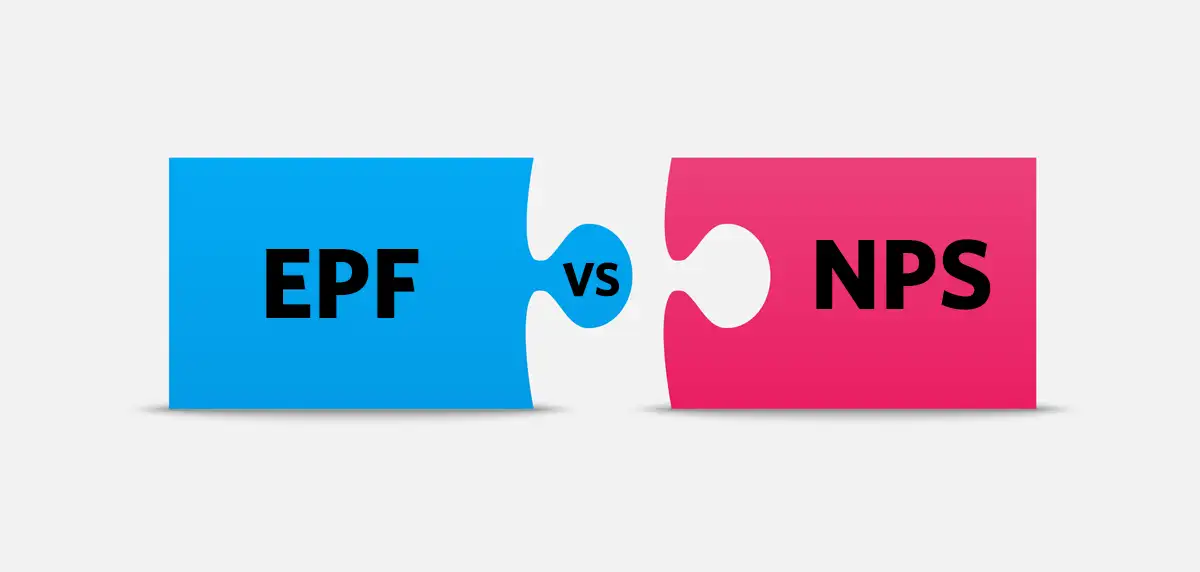Choosing the right retirement savings vehicle is key for financial security in later years. Two prominent, government-backed options in India are the Employee Provident Fund (EPF) and the National Pension System (NPS). Let’s explore the features of each, the difference between EPF and NPS, and some insights on fitting them with your life insurance strategy.
What Is EPF?
The Employee Provident Fund (EPF) is a compulsory retirement savings scheme for salaried employees in India. Managed by the Employees’ Provident Fund Organisation (EPFO), both the employee and employer contribute 12% of the employee’s basic salary and dearness allowance every month. The combined corpus, along with interest, becomes available upon retirement or under specific conditions.
Key Features of EPF
Mandatory Contribution:
Applicable to employees drawing a basic salary of up to a minimum of ₹15,000 per month. Employers also match the 12% contribution.
Interest Rate:
The government declares the interest rate annually. For the fiscal year 2024–25, it is 8.15% per annum, and it remains tax-free if certain conditions are met.
Withdrawal Rules:
Partial withdrawals are permissible for reasons such as medical emergencies, marriage, or education. For complete withdrawal, an employee must exit employment and wait for 1-2 months of unemployment (after which they can withdraw the entire corpus).
Tax Benefits:
Employee contributions up to 12% of salary qualify for deduction under Section 80C of the Income Tax Act. Interest and maturity proceeds are also tax-free if the account has been active for five continuous years.
EPFO Claim Settlement Changes:
Recent EPFO claim settlement changes have streamlined the withdrawal process. Now, members can track their claim online, and auto-transfer of funds is facilitated when changing jobs using Universal Account Number (UAN).
How to Withdraw PF and EPF?
Understanding how to withdraw PF and EPF is essential if you plan to make early withdrawals or claim your full EPF corpus.
Here’s a quick guide:
Step 1. Ensure UAN Activation:
Link your Universal Account Number (UAN) to your EPF account and activate it through the EPFO portal. Ensure your KYC details (Aadhaar, PAN, and bank account) are updated and verified.
Step 2. Submit Withdrawal Form:
Log in to the EPFO member portal using your UAN and password. Navigate to the “Online Service” tab and select “Claim (Form 31, 19 & 10C).” Choose the appropriate form based on your withdrawal scenario.
Step 3. Specify Withdrawal Reason:
For partial withdrawals (e.g., home purchase, marriage, education), specify the reason. For a full withdrawal, select “Full EPF Settlement” if unemployed for more than two months.
Step 4. Submit Digital Signature or Attestation:
Submit the form online with a digital signature if you have one. Alternatively, you may need to download a physical form and get it attested by your employer.
Step 5. Track EPFO Claim Status:
After submission, you can monitor your EPFO Claim Settlement and track the status or any changes online. The EPFO portal updates the claim status at each stage, ensuring transparency.
Step 6. Receive Funds:
Upon approval, the EPF amount is directly credited to your bank account linked to your EPF profile.
What Is NPS?
The National Pension System (NPS) is a voluntary, long-term retirement savings scheme. It is regulated by the Pension Fund Regulatory and Development Authority (PFRDA). Open to all Indian citizens aged 18–70, NPS offers investment options and allows you to build a retirement corpus over time.
Key Features of NPS
Flexible Contribution:
Investors can contribute any amount, with a minimum of ₹1,000 per contribution for Tier 1 accounts. Tier 2 accounts have no minimum annual contribution requirement.
Investment Choices:
Subscribers choose from various asset classes - Equity (up to 75%), Corporate Bonds, and Government Securities.
Tax Benefits:
Contributions up to ₹1.5 lakh (combined under Section 80CCD) are eligible for tax deduction. An additional deduction of ₹50,000 is available under Section 80CCD(1B) for NPS investments.
NPS Tier 1 & Tier 2:
Tier 1 is the primary retirement account with stringent withdrawal rules but higher tax benefits. Tier 2 is a voluntary savings account offering greater liquidity, as withdrawals are permitted anytime.
NPS Annuity:
Upon reaching retirement age (60 years), subscribers must use at least 40% of the Tier 1 corpus to purchase a life annuity. This ensures a regular pension payout. The remaining 60% can be withdrawn as a lump sum, which is tax-free.
EPF vs NPS: Key Comparisons
Below is a detailed comparison between the two schemes, emphasising the difference between EPF and NPS.
Feature
| EPF
| NPS
|
Eligibility
| Mandatory for salaried employees
| Open to all Indian citizens (18–70 years)
|
Contribution Structure
| Fixed 12% of basic pay (employee and employer)
| Flexible contributions; minimum ₹1,000/year for Tier 1
|
Investment Options
| Entire corpus is invested in government securities and high-rated corporate bonds
| Choice of a mix of equities, corporate bonds, and government securities
|
Interest/Return
| Fixed interest rate declared annually (8.15% in 2024–25)
| Market-linked returns based on fund performance
|
Lock-in Period
| Until retirement or two months of unemployment
| Tier 1 locked-in until 60 (with partial withdrawal options); Tier 2 not locked-in
|
Tax Benefits
| Section 80C deduction for employee contribution; tax-free interest
| Section 80CCD deductions, including additional ₹50,000 under 80CCD(1B); partial tax exemption at withdrawal
|
Withdrawal Rules
| Complete withdrawal after 2 months of unemployment; partial withdrawal for specific needs
| Partial withdrawals in specific cases; mandatory annuity purchase from 40% corpus at retirement
|
Annuity Requirement
| Not applicable
| NPS Annuity must be purchased for 40% of corpus at retirement
|
Understanding the Difference Between EPF and NPS
Here are some of the differences between EPF and NPS
1. Nature of Contributions:
In EPF, both employee and employer contribute a fixed percentage of salary. In NPS, contributions are entirely voluntary, with no employer match (unless offered by an employer-supported NPS scheme).
2. Investment Strategy:
EPF invests primarily in government-backed securities, offering predictable returns. NPS allows subscribers to choose their asset allocation, exposing them to market risks and potentially higher returns.
3. Lock-in and Withdrawal:
EPF is locked until resignation and a two-month waiting period. NPS Tier 1 funds are usually locked until retirement, with limited early withdrawal options. Conversely, Tier 2 of NPS offers liquidity unlike EPF.
4. Tax Treatment:
While both offer tax benefits under Section 80C, NPS has an edge with the additional deduction under Section 80CCD(1B). At withdrawal, EPF maturity proceeds are tax-free if the service period is over five years. For NPS, 60% of the withdrawn corpus is tax-free, whereas 40% used for annuity is taxed as per the annuity income.
5. Payout Structure:
EPF provides a lump-sum corpus at retirement (unless partially withdrawn earlier). NPS provides a combination of lump-sum withdrawal (up to 60%) and regular pension payments via NPS Annuity.
NPS vs EPF: Which Suits You Better?
You can consider the following factors when deciding between NPS and EPF
Risk Appetite:
If you prefer guaranteed returns, EPF is more suitable. If you can tolerate market fluctuations for potentially higher returns, NPS might be ideal.
Retirement Goals:
For those keen on regular retirement income, NPS’s annuity feature provides periodic payouts. EPF’s lump-sum nature may require careful investment post-retirement to generate regular income.
Tax Considerations:
NPS offers additional tax benefits under Section 80CCD(1B), making it attractive for high-income earners looking to maximise deductions.
Liquidity Needs:
If you anticipate needing funds before retirement, NPS Tier 2 allows withdrawal anytime. EPF is less liquid, allowing early withdrawals only for specific emergencies.
Integrating EPF and NPS with Life Insurance
For comprehensive financial planning, combining provident funds with a life insurance policy can safeguard you and your dependents:
1. Risk Coverage:
While EPF vs NPS analyses focus on building a retirement corpus, neither scheme provides dedicated life cover. A term life insurance plan fills this gap, offering financial protection for your family in case of an untimely demise.
2. Tax Efficiency:
Both EPF and NPS contributions qualify for deductions under Section 80C. Premiums paid for life insurance also qualify for deductions, enabling you to maximise tax savings.
3. Retirement Income:
After retirement, NPS provides an annuity, and EPF gives a lump sum. By purchasing an annuity rider under your life insurance policy, you can further enhance your monthly post-retirement income.
4. Debt-Free Retirement:
If you have outstanding home or personal loans, ensuring your family has adequate life cover can prevent debt from burdening them in your absence.
5. Estate Planning:
EPF and NPS corpus can be nominated to your beneficiaries. Similarly, life insurance proceeds can financially support your loved ones.
Deciding between EPF and NPS depends on your individual needs, risk tolerance, and retirement goals. Understanding the difference between EPF and NPS can help you make an informed choice.
- EPF offers stability, ease of management, and guaranteed returns.
- NPS provides flexibility in investment, potential for higher returns, and a structured annuity payout.
Leveraging the strengths of both—by continuing EPF contributions if you are salaried and simultaneously investing in NPS—can yield a diversified and robust retirement portfolio. Always track your savings, stay informed about EPFO claim settlement changes, and understand how to withdraw PF and EPF effectively.
Complementing these schemes with a suitable life insurance policy ensures comprehensive protection for you and your family. With disciplined savings, informed decisions, and timely utilisation of available tools, you can build a secure and stress-free retirement.





















